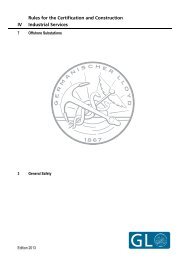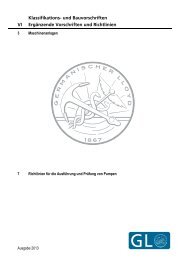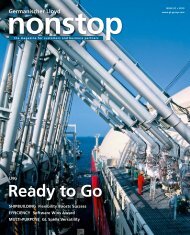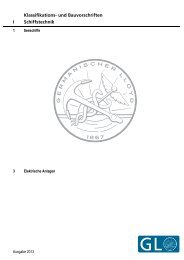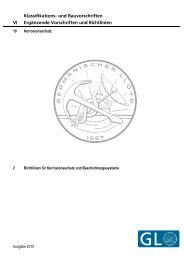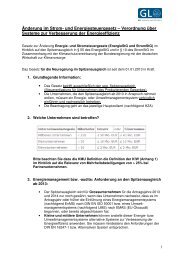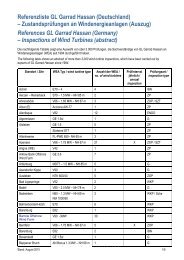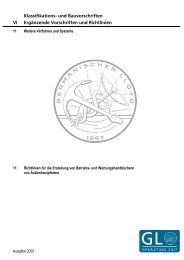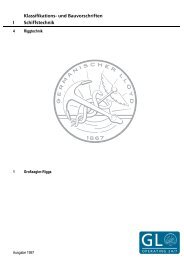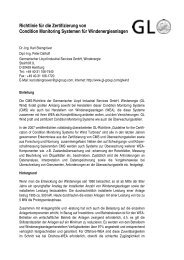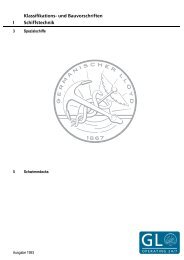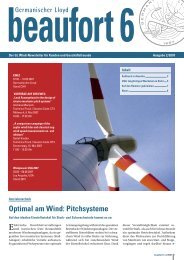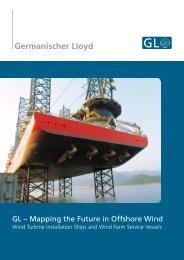energize oil & gas – issue 01-2013 - GL Group
energize oil & gas – issue 01-2013 - GL Group
energize oil & gas – issue 01-2013 - GL Group
You also want an ePaper? Increase the reach of your titles
YUMPU automatically turns print PDFs into web optimized ePapers that Google loves.
wall theory for the principal stress components. This compares<br />
well with the failure pressures predicted by the FEA.<br />
According to a comparison with the FE results for undamaged<br />
specimens, the repaired bends are predicted to be as<br />
strong as the undamaged components, as required by the<br />
spool test survival criteria (see also in Figure 8).<br />
The acceptance criterion under the requirements of the<br />
ISO 24817 short-term spool survival test is that the repaired<br />
section survives a test pressure equal to P f . It is not intended<br />
to be a test to failure and it is therefore expected that<br />
P f be less than the actual failure pressure. However, the<br />
intention of the repair is stated as being to “restore the<br />
pipe spool to pressure P f ”, the implication being that the<br />
repaired section should be at least as strong as the undamaged<br />
section. It may therefore be more representative to<br />
use a test pressure that is calculated based on von Mises<br />
stresses multiplied by a design factor.<br />
Conclusions and Recommendations<br />
The main conclusions from the work undertaken to evaluate<br />
the applicability of the two composite repair methods<br />
for use as temporary repairs are:<br />
I. 90° bends with a 1.5 D radius and a corrosion patch<br />
located on the bend intrados were selected for the FEA<br />
as this geometry is shown to be the most conservative.<br />
II. The unrepaired bends are all predicted to fail in the<br />
centre of the corrosion patch at a pressure considerably<br />
below that required to pass the short-term survival test.<br />
III. For both repair materials assessed, the pipe away from<br />
the repaired section is predicted to fail before the repaired<br />
bend. Furthermore, the predicted failure pressure<br />
exceeds the pressure required to satisfy the<br />
requirements of the short-term survival test for<br />
all geometries assessed.<br />
IV. Full-scale tests can be conducted using any of<br />
the geometries and materials assessed in this<br />
report. The decision should be made on availability of<br />
pipe material and geometry. Approval will ensure that<br />
the operator is in a position to react more quickly when<br />
pipeline damage is detected, thus minimising the risk of<br />
loss of supply.<br />
To verify the applicability of the repair method for longterm<br />
repairs on bends, additional work is recommended<br />
to cover different loading scenarios, pressure/temperature<br />
cycling, debonding, etc.<br />
JC<br />
<strong>GL</strong> <strong>Group</strong> Expert:<br />
Julie Crossley<br />
Senior Integrity Engineer<br />
Phone: +44 1509 282073<br />
E-Mail: julie.crossley@gl-group.com<br />
LPF.<br />
Load proportionality<br />
factor<br />
for the risks<br />
analysis.<br />
References<br />
[1] ASME PCC-2-2<strong>01</strong>1, “Repair of Pressure Equipment and Piping”,<br />
The American Society of Mechanical Engineers, April 2<strong>01</strong>1<br />
[2] DD CEN ISO/TS 24817:2<strong>01</strong>1/TS, “Petroleum, petrochemical<br />
and natural <strong>gas</strong> industries <strong>–</strong> Composite repairs for pipework <strong>–</strong><br />
Qualification and design, installation, testing and inspection.”,<br />
British Standards Institution, June 2<strong>01</strong>1<br />
[3] PRCI Report, Catalogue No. L52318, “State of the Art Assessment<br />
of Composite Repair Systems MAT-3-3”, Pipeline Research<br />
Council International, Inc., October 2<strong>01</strong>1<br />
[4] ASME/BPVC Section VIII Division 2, “Alternative Rules <strong>–</strong> Rules<br />
for Construction of Pressure Vessels”, American Society of Mechanical<br />
Engineers, July 2<strong>01</strong>0<br />
<strong>01</strong>/2<strong>01</strong>3<br />
41



